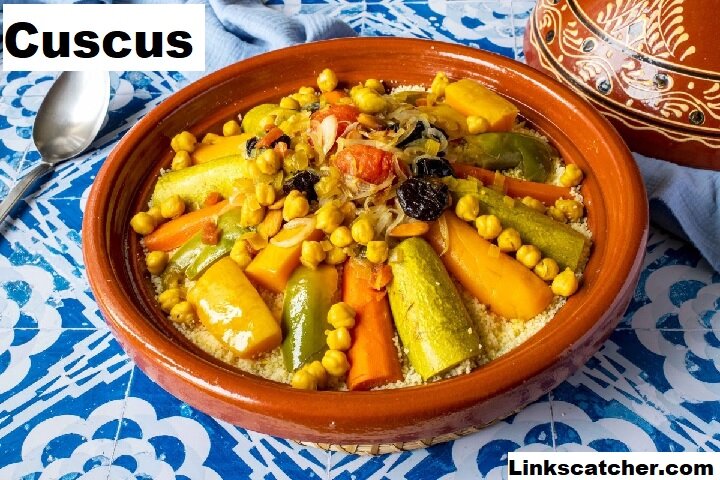
What is Cuscus?
Cuscus might seem like a simple grain, but it’s far from ordinary. This tiny, pearl-like pasta is made from crushed steamed wheat. Originating from North Africa, couscous is not just a staple; it’s a versatile dish that has won hearts worldwide.
Historical Origins and Cultural Significance
Cuscus has been around for centuries, with its roots deeply embedded in Berber culture. Traditionally, it’s prepared during significant occasions, from family gatherings to festive celebrations. The preparation and sharing of couscous have deeply ingrained in North African hospitality and culinary traditions.
Types of Cuscus
Cuscus comes in various forms: traditional, whole grain, and instant. Traditional cuscus has steamed and fluffed by hand, while instant cuscus has pre-steamed and only needs water to prepare. Each type offers a different texture and cooking time, catering to various culinary needs.
Nutritional Benefits of Cuscus
Macronutrient Breakdown
Cuscus has often praised for its balanced macronutrient profile. A serving typically provides a good amount of carbohydrates, with a moderate level of protein and minimal fat. It’s a great choice for those seeking a quick energy boost.
Vitamins and Minerals
Rich in B vitamins, cuscus supports energy metabolism and overall health. It also contains essential minerals like selenium, which plays a role in antioxidant protection. These nutrients contribute to maintaining a balanced diet.
Health Benefits
Incorporating cuscus into your diet can offer numerous health benefits. It supports digestive health, helps in weight management, and provides sustained energy levels. Its low-fat content makes it a heart-healthy choice for many.
How to Prepare Couscous

Basic Cooking Techniques
Cooking cuscus is straightforward. For traditional couscous, you’ll need to steam it over a pot of simmering water or broth. Instant cuscus is even easier—just adds hot water or broth, let it sit, and fluff with a fork. The key is to use the right water-to-couscous ratio to achieve the perfect texture.
Flavored Couscous Recipes
Elevate your cuscus with flavors like lemon zest, herbs, or spices. For a Mediterranean twist, try adding olives and feta. If you prefer something spicy, mix in some harass and roasted vegetables.
Tips for Perfect Texture
To avoid clumps, make sure to fluff your cuscus with a fork after cooking. Adding a bit of olive oil or butter can also enhance the texture and flavor. Keep it light and airy to get that perfect cuscus texture.
Cuscus in Global Cuisine
North African Couscous Dishes
North African cuisine features cuscus in its most traditional form, often served with slow-cooked meats, vegetables, and a rich broth. Dishes like cuscus with lamb and chickpeas are classic and showcase the grain’s versatility.
Middle Eastern Couscous Recipes
In Middle Eastern cuisine, cuscus has used in a variety of dishes, from savory stews to refreshing salads. Try cuscus with roasted vegetables or a spiced meat dish for an authentic taste of the region.
Modern Twists and Fusion Cuisine
Cuscus has made its way into modern kitchens with innovative recipes. Fusion cuisine combines cuscus with ingredients from different culinary traditions, creating unique and delicious dishes. Think couscous sushi rolls or couscous-stuffed bell peppers.
Common Mistakes to Avoid
Overcooking Couscous
Overcooked cuscus can become mushy and unappetizing. Stick to the recommended cooking times and avoid excess water to keep it light and fluffy.
Disproportioned Ingredients
Using too much or too little water can affect the texture of your cuscus. Always follow the package instructions for the correct ratio and avoid adding too much liquid.
Ignoring Seasoning
Cuscus on its own can be bland, so don’t forget to season it well. Herbs, spices, and a touch of salt can make a big difference in flavor. Taste and adjust as needed.
Creative Cuscus Recipes
Cuscus isn’t just for lunch or dinner. Try it for breakfast by mixing it with yogurt, fruit, and a drizzle of honey. It’s a great way to start your day with a nutritious, satisfying meal.
Salad Recipes Featuring Cuscus
Cuscus salads are perfect for a light yet hearty meal. Combine cuscus with fresh vegetables, herbs, and a tangy vinaigrette for a refreshing and colorful salad. Incorporate cuscus into soups and stews for added texture and heartiness. It absorbs flavors well, making it a great addition to any comforting dish.
How to Store and Reheat Cuscus
Cooked cuscus should stored in an airtight container in the fridge. It can stay fresh for about 3 to 4 days. If you have leftover couscous, make sure it’s cooled completely before storing it. Reheat couscous by steaming it lightly or microwaving it with a splash of water to prevent it from drying out. Fluff it with a fork to restore its texture and avoid clumping.
Conclusion
Cuscus is more than just a side dish—it’s a versatile ingredient with a rich history and numerous health benefits. Whether you’re trying it for the first time or looking to explore new recipes, cuscus can add a delightful touch to your meals. Experiment with different flavors and preparations, and enjoy this global staple in your kitchen.
FAQs
What is the difference between cuscus and quinoa?
Cuscus is a type of pasta made from wheat, while quinoa is a seed. Both are nutritious, but quinoa is gluten-free and contains higher protein content.
Can cuscus be made gluten-free?
Traditional cuscus contains gluten, but there have gluten-free alternatives available made from corn or rice flour.
How long does cooked cuscus last in the fridge?
Cooked cuscus can stored in the fridge for up to 3 to 4 days. Make sure it’s stored in an airtight container.
Can I use cuscus in baking?
Yes, cuscus can used in baking as a substitute for other grains. It adds a unique texture to baked goods.
What are some easy ways to flavor cuscus?
Flavored cuscus can enhanced with herbs, spices, citrus zest, or a splash of broth. Experiment with different seasonings to find your favorite combination.